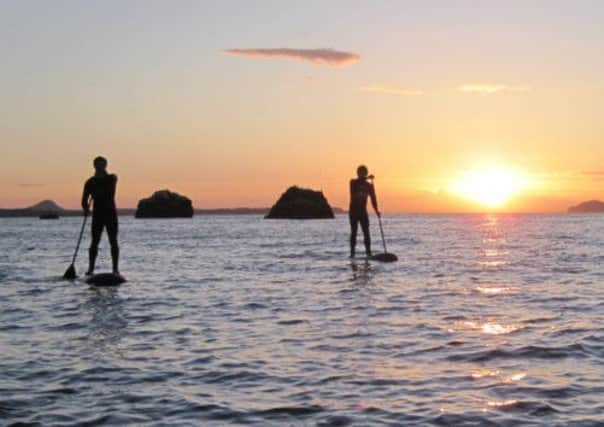Roger Cox: Stand up paddling - the surfing alternative


Mountainboarding, I’ve discovered, is a lot more fun than complaining that there’s no snow and the surf’s flat. And now, thanks to Sam Christopherson, head honcho at Coast to Coast surf school in Dunbar, I can add stand-up paddling – or SUP for short – to my small but growing list of plan B activities.
Although it’s often referred to as a new or emerging sport, having only gone mainstream in the last ten years or so, SUP has roots that go deep into Hawaiian culture. Watch old newsreel footage of the Waikiki beach boys teaching tourists to surf in the 1940s and you’ll see some of them paddling into waves lying prone on their boards like today’s surfers and others catching waves standing up, using canoe paddles to propel themselves through the water. The DNA of SUP was right there at the birth of modern surfing; it just took a bit longer to catch on.
Advertisement
Hide AdAdvertisement
Hide AdWhen I meet Sam at the C2C surf hub by Dunbar station he explains that, because there’s a stiff southwesterly blowing, we’re going to do a “downwinder” – a wind-assisted paddle from John Muir Country Park on the west side of Dunbar, around the rocks and reefs that fringe the town, and then on to East Beach. One reason for SUP’s growing popularity is that, unlike conventional surfing, you don’t need waves. When the surf goes flat, you can use your board as an inshore exploration vessel – a bit like a sea kayak, only with a much better view and practically zero consequences if you fall into the drink.
We heave two giant surfboards into the back of his van, throw in a couple of funny-looking paddles and head for the coast. After a brief on-land introduction we launch our boards at the mouth of the Biel Water, the little river that issues out into the south end of Belhaven Bay. To begin with we paddle out to sea lying down as if we’re on conventional surfboards, with our paddles tucked under our chests. Next, Sam has me get up on to my knees and paddle as if I’m in a Canadian canoe until we’re in deep enough water to try standing. I’d assumed this next bit would be easy, but with a 20mph wind kicking up unruly, short-interval chop it’s surprisingly tricky to stay on my feet. Unlike kayaking, though, where a capsize can be a bit of a palaver, falling off a SUP is pure, slapstick fun, and we’re soon making progress, picking our way through a cluster of rocks, finding a sheltered channel between a long, rocky islet and the shore. A couple of inquisitive seals pop up about 20 feet to our left and one of them decides to follow us for a while.
The reefs around Dunbar are a maze, and in places there are deep, narrow grooves in the rock just wide enough for a SUP to pass through. We surf our way into one of these gullies on the back of a gentle swell, get stuck on the bottom as the water recedes and then get pushed forwards again as the next wave comes rolling in behind us. After a bit of hopping, wriggling and portaging we end up in a small, circular pool – three metres deep and a good place to go looking for fish with a mask and snorkel.
Back in open water again, we paddle towards the mouth of Dunbar’s Victoria Harbour – a narrow channel with tall, dark cliffs on either side. Sam’s just explaining the importance of keeping an eye out for boats when, right on cue, a yellow trawler comes barrelling through the gap. Keeping a careful eye out for more boats, we scoot into the harbour, entering a serene, windless millpond. Without the constant wobble of the chop and the buffeting of the breeze, weaving slowly between boats feels almost meditative. We cruise silently under a bridge and into the Old Harbour, climb up a slipway and then carry our boards over some rocks before launching them again on East Beach. Here, sheltered from the wind, the water is as smooth and clear as glass, and from my vantage point six feet above the surface I can see every last shell and pebble on the bottom. As we hop off our boards on to warm, golden sand, I wonder if this plan B activity might one day become a plan A.